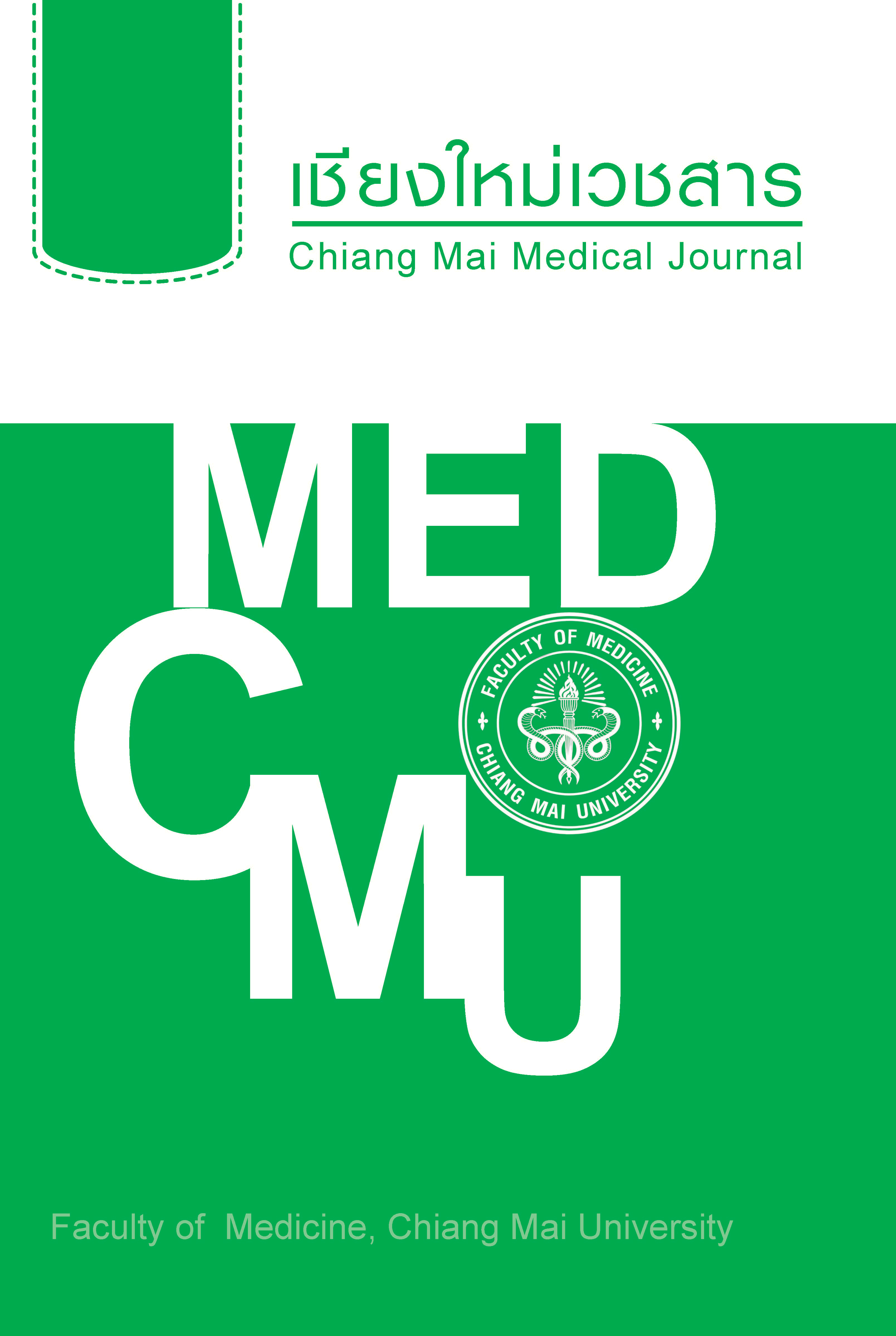Survey of sand flies and Leishmania infection in Doi Saket District, Chiang Mai Province, Thailand
Keywords:
Sand flies, Habitat, population density, Leishmania DNA, Chiang MaiAbstract
Objectives To survey sand flies in areas near the residence of a leishmaniasis patient’s home in Doi Saket District, Chiang Mai Province, Thailand and examine the Leishmania DNA.
Methods Sand flies were collected using CDC light traps for two consecutive nights between 6 PM and 6 AM from February through September 2016. The study areas included rice fields, banana trees, chicken coops, and stacks of firewood. The Leishmania DNA was examined using a PCR method.
Results A total of 863 adult sand flies were collected. Among the 425 females, five species were morphologically identi fied, i.e., Phlebotomus stantoni, Sergentomyia gemmea, S. barraudi, S. indica, and S. hivernus. Sergentomyia indica was the predominant species. Most of the flies were collected from chicken coops. The highest density of sand flies captured was in May with an average temperature of about 29 ºC and relative humidity of approximately 61%. No Leishmania DNA was
detected in any of the sand flies collected in this study.
Conclusions This study provided information on the different distribution patterns of sand fly species in Doi Saket District, Chiang Mai Province, Thailand where the leishmaniasis case was located. No Leishmania DNA was detected in the sand flies collected in this study. Further study is required to better understand the vector status of sand flies in Thailand.
References
2. Leelayoova S, Siripattanapipong S, Manomat J, Piyaraj P, Tan-Ariya P, Bualert L, et al. Leishmaniasis in Thailand: A Review of Causative Agents and Situations. Am J Trop Med Hyg. 2017;96:534-42.
3. Pothirat T, Tantiworawit A, Chaiwarith R, Jariyapan N, Wannasan A, Siriyasatien P, et al. First isolation of Leishmania from Northern Thailand: case report, identification as Leishmania martiniquensis and phylogenetic position within the Leishmania enriettii complex. PLoS Negl Trop Dis. 2014; 8:e3339.
4. Chiewchanvit S, Tovanabutra N, Jariyapan N, Bates MD, Mahanupab P, Chuamanochan M, et al. Chronic generalized fibrotic skin lesions from disse-minated Leishmaniasis caused by Leishmania martiniquensis in two patients from northern Thailand infected with HIV. Br J Dermatol. 2015;173: 663-70.
5. Chusri S, Thammapalo S, Silpapojakul K, Siriya-satien P. Animal reservoirs and potential vectors of Leishmania siamensis in southern Thailand. Southeast Asian J Trop Med Public Health. 2014; 45:13-9.
6. Polseela R, Jaturas N, Thanwisai A, Sing KW, Wilson JJ. Towards monitoring the sand flies (Diptera: Psychodidae) of Thailand: DNA barcoding the sand flies of Wihan Cave, Uttaradit. Mitochondrial DNA Part A. 2016;27:3795-801.
7. Phumee A, Tawatsin A, Thavara U, Pengsakul T, Thammapalo S, Depaquit J, et al. Detection of an Unknown Trypanosoma DNA in a Phlebotomus stantoni (Diptera: Psychodidae) Collected From Southern Thailand and Records of New Sand Flies With Reinstatement of Sergentomyia hivernus Raynal & Gaschen, 1935 (Diptera: Psychodidae). J Med Entomol. 2017;54:429-34.
8. Tiwananthagorn S, Kato H, Yeewa R, Muengpan A, Polseela R, Leelayoova S. Comparison of LAMP and PCR for molecular mass screening of sand flies for Leishmania martiniquensis infection. Mem Inst Oswaldo Cruz. 2017;112:100-7.
9. Sor-suwan S, Jariyapan N, Mano C, Apiwathnasorn C, Sriwichai P, Samung Y, et al. Species composition and population dynamics of phlebotomine sand flies in a Leishmania infected area of Chiang Mai, Thailand. Trop Biomed. Submitted.
10. Theodor O. On Sand flies (Phlebotomus) from Ceylon, Siam, and Malay. Indian J Med Res. 1938;
26:261-9.
11. Quate LW. A review of the Indo-Chinese Phlebotomine (Diptera: Psychodidae). Pacif Insects. 1962; 4:251-67.
12. Lewis DJ. The Phlebotomine sand flies (Diptera: Psychodidae) of the Oriental Region. Bulletin of the British Museum (Natural History) Entomol Ser. 1978;37:217-343.
13. Lewis DJ. Phlebotomine sand flies (Diptera: Psychodidae) from the Oriental Region. Syst Entomol. 1978;12: 163-80.
14. Spanakos G, Piperaki ET, Menounos PG, Tegos N, Flemetakis A, Vakalis NC. Detection and species
identification of Old World Leishmania in clinical samples using a PCR-based method. Trans R Soc Trop Med Hyg. 2008;102:46-53.
15. Sukmee T, Siripattanapipong S, Mungthin M, Worapong J, Rangsin R, Samung Y, et al. A suspected new species of Leishmania, the causative agent of visceral Leishmaniasis in a Thai patient. Int J Parasitol. 2008;38:617-22.
16. Sukra K, Kanjanopas K, Amsakul S, Rittaton V, Mungthin M, Leelayoova S. A survey of sand flies in the affected areas of Leishmaniasis, southern Thailand. Parasitol Res. 2013;112:297-302.
17. Kanjanopas K, Siripattanapipong S, Ninsaeng U, Hitakarun A, Jitkaew S, Kaewtaphaya P, et al. Sergentomyia (NeoPhlebotomus) gemmea, a potential vector of Leishmania siamensis in southern Thailand. BMC Infect Dis. 2013;13:333.
18. Tiwananthagorn S, Bhutto AM, Baloch JH, Soomro FR, Kawamura Y, Nakao R, et al. Zoophilic feeding behaviour of phlebotomine sand flies in the endemic areas of cutaneous Leishmaniasis of Sindh Province, Pakistan. Parasitol Res. 2012; 111:125-33.
19. Maia C, Parreira R, Cristóvão JM, Freitas FB, Afonso MO, Campino L. Molecular detection of Leishmania DNA and identification of blood meals in wild caught phlebotomine sand flies (Diptera: Psychodidae) from southern Portugal. Parasit Vectors. 2015;8:173.
20. Seblova V, Sadlova J, Vojtkova B, Votypka J, Carpenter S, Bates PA, et al. The Biting Midge Culicoides sonorensis (Diptera: Ceratopogonidae) Is Capable of Developing Late Stage Infections of Leishmania enriettii. PLoS Negl Trop Dis. 2015;9: e0004060.
21. Dougall AM, Alexander B, Holt DC, Harris T, Sultan AH, Bates PA, et al. Evidence incriminating midges (Diptera: Ceratopogonidae) as potential vectors of Leishmania in Australia. Int J Parasitol. 2011;41:571-9.
22. Bualert L, Charungkiattikul W, Thongsuksai P, Mungthin M, Siripattanapipong S, Khositnithikul R, et al. Autochthonous disseminated dermal and visceral Leishmaniasis in an AIDS patient, southern Thailand, caused by Leishmania siamensis. Am J Trop Med Hyg. 2012;86:821-4.
23. Leelayoova S, Siripattanapipong S, Hitakarun A, Kato H, Tan-ariya P, Siriyasatien P, et al. Multilocus characterization and phylogenetic analysis of Leishmania siamensis isolated from autochthonous visceral Leishmaniasis cases, southern Thailand. BMC Microbiol. 2013;13:60.
24. Kwakye-Nuako G, Mosore MT, Duplessis C, Bates MD, Puplampu N, Mensah-Attipoe I, et al. First isolation of a new species of Leishmania responsible for human cutaneous Leishmaniasis in Ghana and classification in the Leishmania enriettii complex. Int J Parasitol. 2015;45:679-84.











